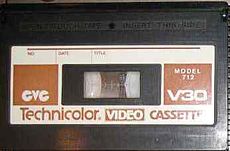- Compact Video Cassette
-
Not to be confused with Video Compact Cassette, better known as Video 2000.
Technicolor Compact Video Cassette (CVC) 
Technicolor Compact Video Cassette (CVC)Media type Magnetic Tape Encoding NTSC, PAL Read mechanism Helical scan Write mechanism Helical scan Standard Interlaced video Developed by Funai, Technicolor Usage Home movies Compact Video Cassette (CVC) was one of the first analog recording videocassette formats to use a tape smaller than its earlier predecessors of VHS and Betamax, and was developed by Funai Electronics of Japan. The first model of VCR for the format was the Model 212, introduced in 1980 by both Funai and Technicolor. The two companies had created a joint venture to manufacture and introduce the format to the home movie market. The system, which included the VCR and a hand held video camera, was very small and lightweight for its time.
The CVC format used a cassette slightly larger than an audio cassette (about 4.124" x 2.625" x 0.5" in size) and was loaded with 1/4" magnetic tape. Unlike most other video cassette formats that have two spools fixed in diameter, the cassette size was able to be made smaller by re-using the space vacated by one spool as the other spool filled up, similar to a standard audio cassette. The tapes for the CVC format came in VC-30 (30 minute) and later VC-45 (45 minute) & VC-60 (60 minute) models. The format was released for both NTSC and PAL television systems, and tapes had to be played on machines using the same TV system as the recording.
Funai Model 212 came with a JVC model GX-44E hand held Vidicon tube camera with a zoom lens. Model 212D was the NTSC version and 212E was PAL for Europe. The deck and electronics from the 212 were also used to build the model 335 Technicolor Video Showcase, which included a colour video monitor, speaker and contained an internal 12V battery. A lightweight television tuner pack was available to allow the 212 to record off-air television programming, but since it contained no timer, unattended recordings would have been hard to arrange. Grundig also produced a CVC-format VCR, the Model VP-100 for the PAL market, specifications were similar to the 212E and recordings were compatible. The VP-100 weighed only 2.3 kg with battery, and had a separate power pack.
Technicolor had hoped that this system would compete with 8mm film. But the Vidicon tube used for the bundled camera had poor low-light sensitivity, limiting its usefulness for home indoor use. Worse, the 1/4"-wide tape was prone to dropouts (appearing as lines of white snow in the video) during video playback, partially due to the smaller tape size. Low tape quality used at that time for the CVC cassettes was also a contributing factor to these dropouts. As the decks aged, the lubrication in the mechanism's loading ring dried out, causing many machines to malfunction.
Specifications
 Siemens CVC Videocassette Recorder
Siemens CVC Videocassette Recorder
- Two Rotary helical scan record heads
- Capstan-driven linear tape speed: 1.26 ips (inches per second) or (32.1 mm/sec)
- Video signal-to-noise (S/N) ratio: 43 dB
- Image resolution: 240-lines
- Audio S/N ratio: 40 dB
- Audio frequency response: 100 Hz to 8 kHz
- 7.16 pounds (3.25 kg)
- Dimensions: 9.2 × 10.2 × 3.1 inches (24 × 26 × 8 cm)
 Technicolor CVC Videocassette recorder with monitor at DC Video [1],
Technicolor CVC Videocassette recorder with monitor at DC Video [1],
External links (and references)
Video storage formats Videotape Quadruplex (1956) · VERA (1958) · Sony 2 inch helical VTR (1961) · Ampex 2 inch helical VTR (1962) · Type A (1965) · CV-2000 (1965) · Akai (1967) · U-matic (1969) · EIAJ-1 (1969) · Cartrivision (1972) · Philips VCR (1972) · V-Cord (1974) · VX (1974) · Betamax (1975) · IVC (1975) · Type B (1976) · Type C (1976) · VHS (1976) · VK (1977) · SVR (1979) · Video 2000 (1980) · CVC (1980) · VHS-C (1982) · M (1982) · Betacam (1982) · Video8 (1985) · MII (1986) · S-VHS (1987) · S-VHS-C (1987) · Hi8 (1989) ·
D1 (1986) · D2 (1988) · D3 (1991) · DCT (1992) · Digital Betacam (1993) · D5 (1994) · Digital-S (D9) (1995) · Betacam SX (1996) · Digital8 (1999) · MicroMV (2001) ·
High DefinitionVideodisc AnalogDigitalHigh DefinitionHD DVD (2006) · Blu-ray Disc (2006) · HVD (Holographic Versatile Disc) (2007) · CBHD (2008)
Digital Media agnosticTapelessVideo recorded to film Kinescope (1947) · Electronicam kinescope (1950s) · Electronic Video Recording (1967)
Categories:- Video storage
- Recording
- 1980 introductions
- Discontinued media formats
Wikimedia Foundation. 2010.
